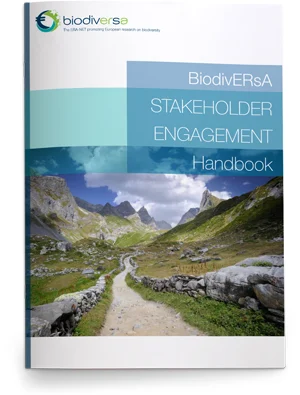The Biodiversa Stakeholder Engagement Handbook is a non-academic practical guide for researchers planning and carrying out research projects. It is designed to assist you identify relevant stakeholders to engage with to enhance the impact of your work. This Handbook draws upon exiting literature and presents case studies that provide clear, simple guidance on ‘why’, ‘who’, ‘when’ and ‘how’ to engage.
To ensure a balanced representation of society is effectively engaged with research activities, the Handbook considers a three-step stakeholder identification process:
- identification of relevant stakeholders;
- assessing and prioritisation;
- and developing understanding.
This process will help you ascertain opportunities and risks of engagement and ensure you are able to recognise and overcome barriers to engagement, making your engagement processes more inclusive. It will also help you enhance the legitimacy and societal relevance of your scientific research.
Not sure if you’ll like our Stakeholder Engagement Handbook?
Read our 4-page digest first!
- PART 1: Introduction
- PART 2: Why engage with stakeholders
- PART 3: How to identify stakeholders
- PART 4: When to engage with stakeholders
- PART 5: Methods for engagement
- PART 6: Planning the detail of the engagement
- PART 7: Managing stakeholder conflict
- PART 8: Monitoring and evaluating the engagement
Annex 1 - Practical Method Notes
- Interviewing stakeholders
- Organising stakeholder workshops
- Participatory Mapping
- How to write a policy brief
- Scenario Analysis
- Co-development of research outputs with stakeholders
- Commissioning and working with video
- Delphi method
- Enabling stakeholders to monitor research outcomes and generate data
- Social Media
- Multi-Criteria Decision Analysis
- Facilitating stakeholder workshops
Annex 2 - Conflict Management Tools
Templates (word documents)
- Stakeholder identification and categorisation (Table 3.1, page 39 of the Handbook)
- Extended interest-influence matrix (Table 3.2, page 44)
- Understanding your stakeholders (Table 3.3, page 48)
- Matrix for planning stakeholder engagement activities (Table 6.1, page 74)
- Matrix for categorising stakeholder dedication (Table 7.1, page 82)
- Stakeholder engagement evaluation (Table 8.1, page 94)
- Evaluating outcomes of stakeholder engagement activities (Table 8.2, page 96)
- Evaluating roles, rights, responsibilities and returns (Annex 2)




